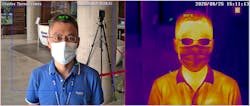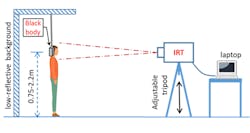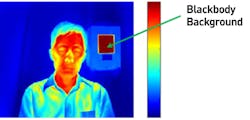This article originally appeared in the September 2020 issue of Security Business magazine. When sharing, don’t forget to mention @SecBusinessMag on Twitter and Security Business magazine on LinkedIn.
As businesses, schools, hospitals and sporting venues look to safely reopen in a COVID-19 world, security professionals are weighing the implementation of a range of options to help keep occupants safe and reduce the spread of the highly contagious virus. With social distancing requirements, stringent cleaning protocols and capacity limitations as part of plans to safely reopen, retailers, office complexes and educational facilities are recognizing that technology will also play a critical role in helping to identify individuals who may have the virus even before that person enters the premises.
Thermal imaging systems are emerging as a solution that will play a critical role in helping to proactively detect an elevated temperature in visitors or employees prior to entry to a facility. Thermal surveillance, a mainstay of traditional physical security and outdoor perimeter detection, is now being deployed to quickly scan employees, contractors and visitors as part of a first line of defense to detect COVID-19 symptoms.
As systems integrators look to implement thermal camera solutions for customers, there are many important differences between the various system types of thermographic devices that can impact their efficacy, as well as the type of applications where they are appropriate. Additionally, proper deployment of the devices is an important factor to ensuring accurate results.Security Business caught up with Jason Ouellette, Head of Technology Business Development for Johnson Controls, to answer these questions and give integrators a playbook when it comes to selling and deploying these systems.
What are some of the different thermal imaging solutions available to detect an elevated temperature in a person?
For the general market, there are three types of these thermographic screenings. There is a handheld device, which is typically lower cost, very portable and very easy to use. Typically, this is a point-and-shoot type of device, but it requires someone to be three feet or less from the person that is being screened – which in today's world, means the user needs to wear Personal Protective Equipment.
The second type of solution would best be described as a thermal camera and kiosk. The advantage of this system over a handheld device is that it can be self-service. An individual would go up to and engage with the kiosk on their own; however, many of these kiosk-type solutions have some integration capability, so they can provide some type of output, for either turnstiles, or physical access control, but not video management systems (VMS). Some of the downsides of this type of system are that it is less accurate than a thermographic solution because it does not have a blackbody temperature calibration device, and the readings are influenced by the surrounding ambient temperature – a scenario called thermal drift. Thus, instead of being able to achieve a ±0.3ºC accuracy rating, this system probably provides closer to ±0.5ºC at best. Some of these devices may be classified as a clinical thermometer with a higher degree of one-time accuracy, but do not offer the speed and endurance of the thermographic solution for adjunctive use.
The third is a thermal imaging camera system with a blackbody temperature calibration device. This system includes a dual-sensor camera with a visual sensor and a thermal sensor built right into the camera, along with a separate blackbody device. This type of system provides the highest degree of ongoing accuracy, because of the blackbody and its ability to provide continuous calibration. These systems can provide much more flexibility and offer integrations with multiple VMS platforms.
When installing a thermal imaging camera system, what is the most important element to consider?
Camera placement is critical to ensure the system works as expected; however, the placement of the blackbody device – which verifies the correct calibration is in place – is equally as important. If the customer wants to follow FDA medical deviceAlso, integrators should minimize camera detection angles to ensure optimal accuracy and install cameras parallel with the face as much as possible – which again is in compliance with installation instructions.
The blackbody should be placed at the outer edge of the field-of-view of the camera (either left or right). Keep in mind the minimum resolution for effective thermographic readings is 320x240 pixels, as defined by the standards. To achieve this, integrators need to follow medical electrical equipment performance standards driven by IEC 80601-2-59:2017 for human temperature scanning and FDA guidelines. Within that measurement, the face needs to fill 240x180 pixels, which is close to or just over 50 percent of the sensor’s viewing area typically – meaning a single person scanned at a time.
Along with height and distance placement considerations, the actual placement in terms of the location of the system is key. For example, an expansive glass entryway may impact accuracy due to sunlight exposure. Installations should be focused on ensuring that they are away from airflow and heating and cooling sources, located approximately 16 feet from entry ways and in as consistent of an ambient temperature as possible between 50°F and 95°F.
Once a thermal imaging camera system is installed, how should it be monitored?
There are several choices for system monitoring, depending on whether the solution is standalone or integrated with other technologies – such as intrusion detection, access control or video recording.
For standalone systems, the ability to receive system alerts is configured through the camera’s webpage, allowing different levels of system monitoring, depending on management roles to include the live web page, LED display, audio alerts and physical relay output. This is all done following cybersecurity best practices, which are important for any network solution today – includingThermal cameras can also integrate with turnstile systems, VMS platforms and access control systems. This is done by integrating with a relay output, activated by a triggered temperature anomaly event on a thermal imaging camera which can be used to lock a turnstile, or through access control and video systems to send an email or provide an automated contagion report for contact tracing. These capabilities and integrations extend the monitoring capability of the standalone solution.
The cameras should also be able to be configured to monitor a specific range of low and high alerts. Users can determine the actions that should be taken when that alert exceeds the preset low or high threshold. A highly visible LED can provide visual notification through pulsing and flashing lights, as an example.
Does a thermal imaging system require regular service and maintenance in order to operate accurately?
First, it is important to make sure the system is calibrated. This can be done after the unit stabilizes for at least 30 minutes to establish the initial reference temperature source – known as the blackbody. Any calibrations conducted before this warmup and stability time period can throw off accuracy. Also, as part of a system maintenance schedule, integrators should perform a calibration check of the blackbody device every 12 months, along with following the recommendations of the FDA and IEC.
If you install the solution and do not perform maintenance, and the blackbody calibration certificate expires, there is a risk that the device will experience drift over time, resulting in a less accurate reading.
Any advice for integrators or end-users on choosing a particular product?
Before you buy a thermal imaging camera, check to see if the manufacturer ships the camera with a calibration certificate. Also, become familiar with FDA’s guidance released in April 2020, Enforcement Policy for Telethermographic Systems During the Coronavirus Disease 2019 (COVID-19) Public Health Emergency. This document places thermal/fever products for adjunctive use under the category of a Class I medical devices and subject to its regulatory control. Driven by these regulations and categorization, stakeholders need to understand specifically what is required to meet the required level of accuracy for successful detection.
Learn more about Johnson Controls' thermal temperature screening system at www.securityinfowatch.com/21147934.
About the Author
Paul Rothman
Editor-in-Chief/Security Business
Paul Rothman is Editor-in-Chief of Security Business magazine. Email him your comments and questions at [email protected]. Access the current issue, full archives and apply for a free subscription at www.securitybusinessmag.com.




